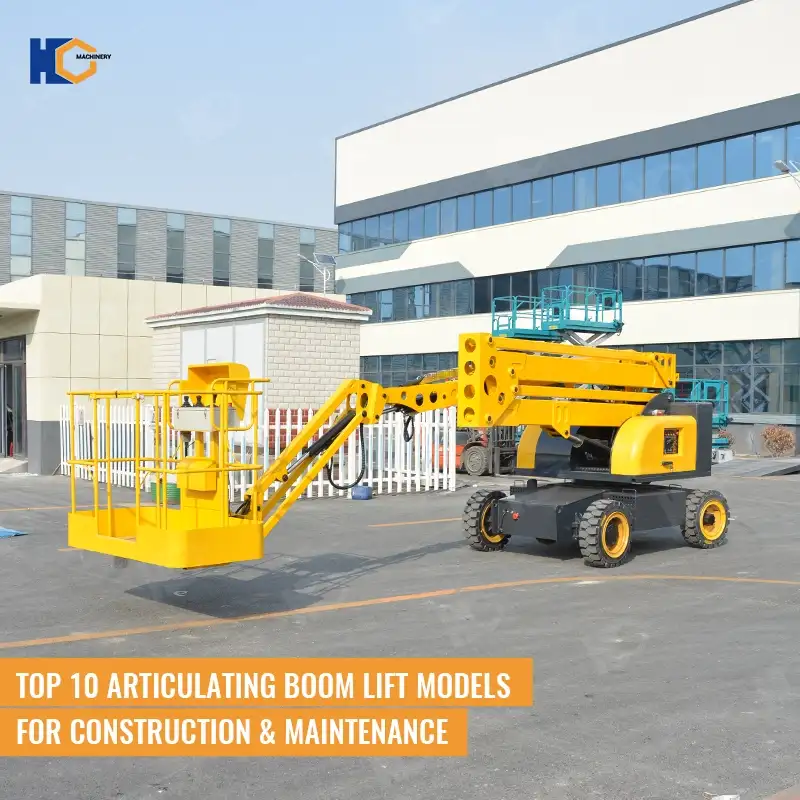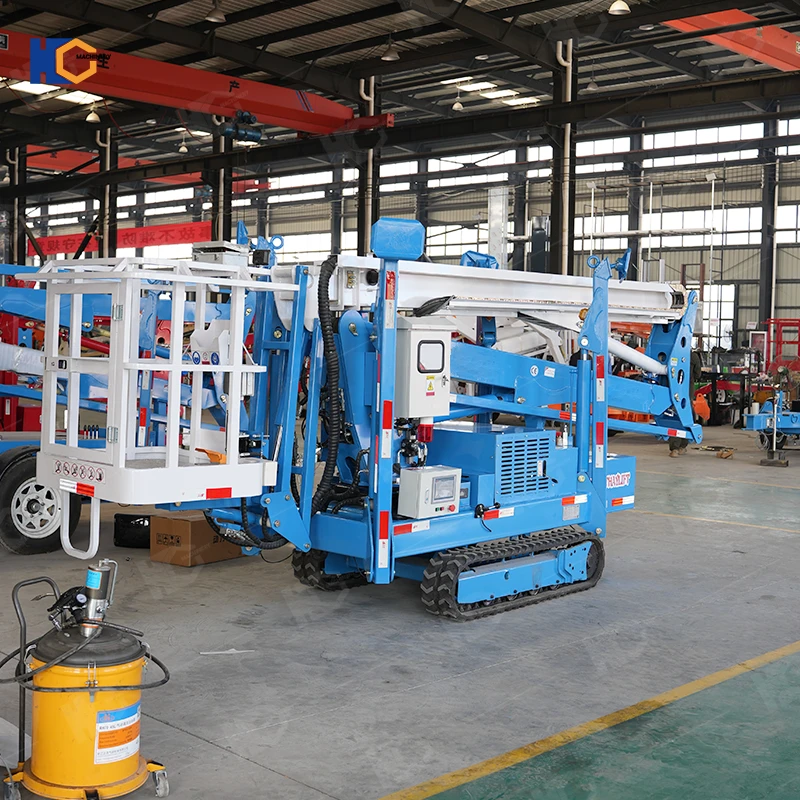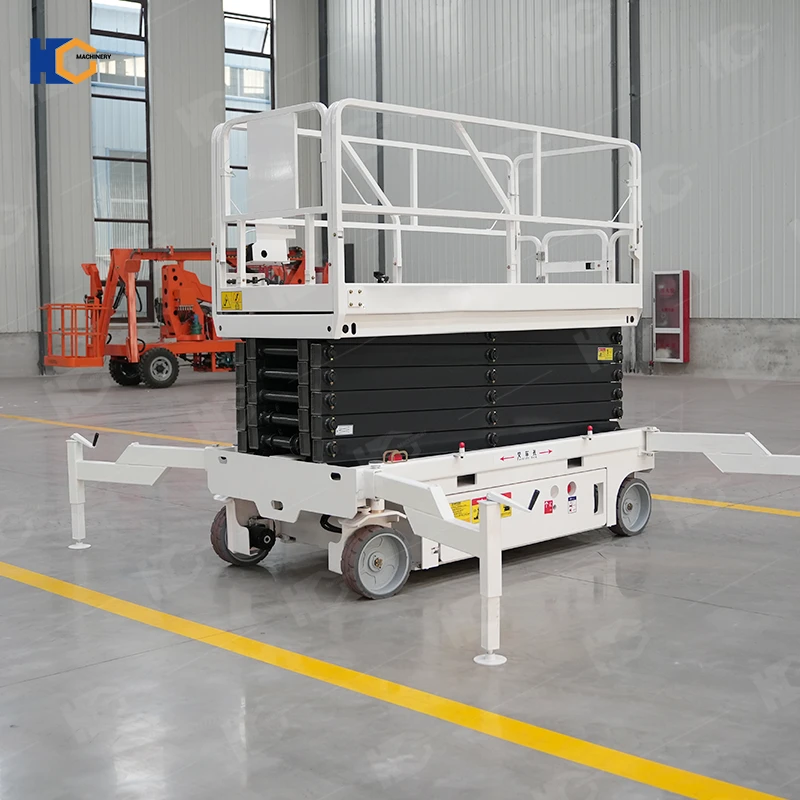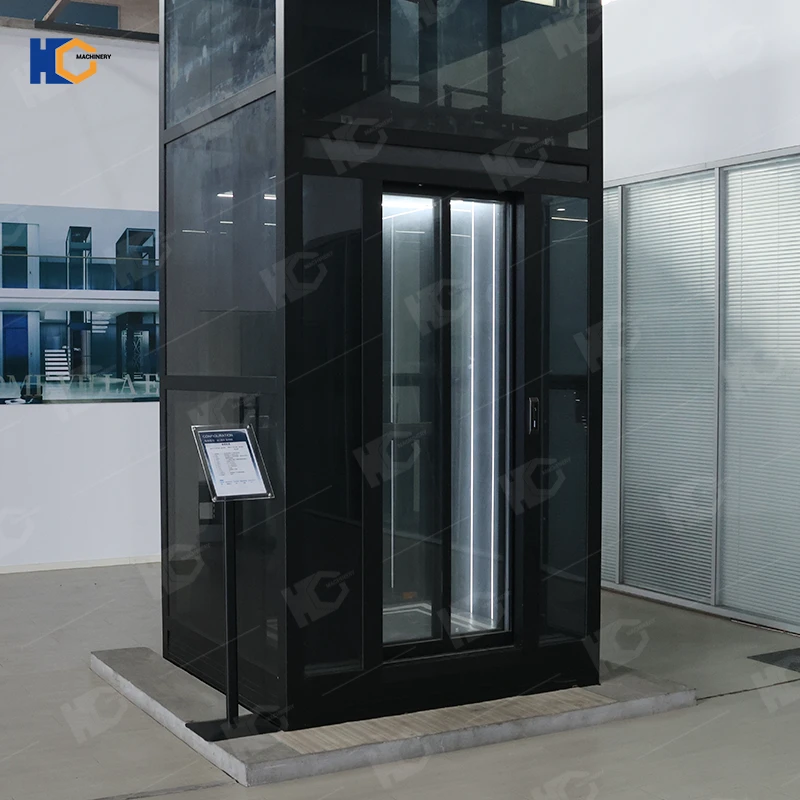Articulating boom lifts, also known as knuckle boom lifts, are versatile aerial work platforms designed to provide safe and efficient access to hard-to-reach areas. These machines feature multiple hinged sections that allow the boom to "articulate" or bend, offering superior maneuverability around obstacles. Key features include adjustable platform heights, 360-degree rotation, and varying load capacities, making them ideal for tasks requiring precision and flexibility. Available in electric, diesel, and hybrid power options, articulating boom lifts can operate both indoors and outdoors, catering to diverse job site requirements.
In construction, maintenance, and industrial applications, articulating boom lifts play a crucial role. Construction crews rely on them for tasks like steel erection, roofing, and exterior finishing, while maintenance teams use them for HVAC repairs, window cleaning, and facility upkeep. Their compact design allows operation in confined spaces, such as warehouses and manufacturing plants, where traditional scaffolding or larger lifts may not be practical. Industries ranging from telecommunications to utilities also depend on these lifts for safe, elevated access.
Choosing the right articulating boom lift model is essential for maximizing safety, efficiency, and cost-effectiveness. The wrong choice can lead to operational delays, increased risks of accidents, or unnecessary expenses. Factors like working height, platform capacity, terrain adaptability, and power source must align with the job’s demands. Investing in the right equipment ensures smoother operations, regulatory compliance, and long-term savings—whether purchasing or renting. This guide explores the top 10 articulating boom lifts to help you make an informed decision for your construction and maintenance needs.
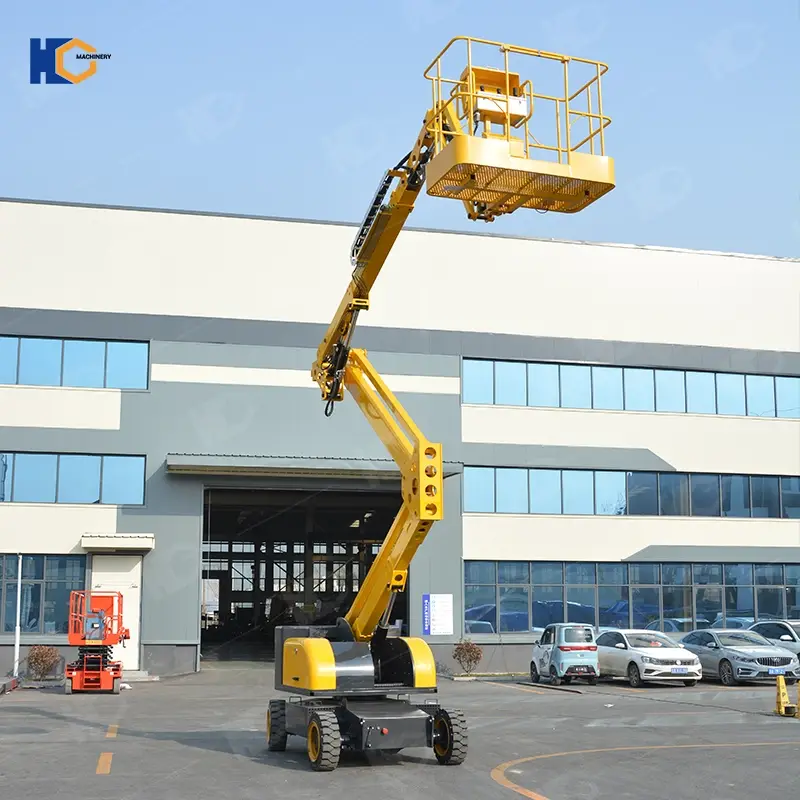
Key Features to Consider When Choosing an Articulating Boom Lift
Selecting the right articulating boom lift requires careful evaluation of several critical features to ensure optimal performance, safety, and cost-efficiency for your specific application. Whether you're working in construction, facility maintenance, or industrial settings, understanding these key factors will help you make an informed decision. Here are the most important considerations when choosing an articulating boom lift:
1. Working Height & Reach (Vertical/Horizontal)
The primary purpose of an articulating boom lift is to provide safe access to elevated work areas. When evaluating models, consider both the maximum working height (platform height) and horizontal reach (how far the boom can extend outward).
Working Height: Typically ranges from 30 to 150+ feet, depending on the model. Taller lifts are ideal for high-rise construction, bridge work, or telecommunications.
Horizontal Reach: Some lifts offer extended outreach, allowing workers to maneuver around obstacles like beams or machinery without repositioning the entire machine.
Articulation Points: More joints (knuckles) mean greater flexibility in tight spaces, such as indoor maintenance or complex structures.
For example, a Genie Z-62/40 offers a 62-foot working height with 40 feet of horizontal reach, making it suitable for construction sites where extended outreach is needed.
2. Platform Capacity (Weight Limits)
The platform capacity determines how much weight the lift can safely support, including workers, tools, and materials.
Standard Capacities: Most lifts support 500 to 1,000 lbs, but heavy-duty models can handle 1,200+ lbs for industrial applications.
Multi-Person vs. Single-Person: Some lifts are designed for two workers, while others are optimized for a single operator with heavy equipment.
Load Distribution: Ensure the weight is evenly distributed to prevent instability.
For tasks requiring multiple workers and heavy tools, a JLG 600S (with a 500-lb capacity) may suffice, while a Manitou 180 TJ (supporting 1,200 lbs) is better for industrial use.
3. Maneuverability (Compact Design, Rough-Terrain vs. Indoor Use)
The work environment significantly impacts the type of boom lift needed.
Compact Design: Essential for indoor use, warehouses, or facilities with narrow aisles. Models like the Snorkel A46JE feature a zero tail swing for tight spaces.
Rough-Terrain Capability: For outdoor construction sites, look for 4x4 drive systems, all-terrain tires, and high ground clearance (e.g., Genie SX-180 XC).
Tracked vs. Wheeled: Tracked lifts distribute weight better on soft ground, while wheeled models are faster on hard surfaces.
4. Power Options (Electric, Diesel, Hybrid)
The power source affects performance, noise levels, and emissions.
Electric Boom Lifts: Best for indoor use (quiet, zero emissions), but limited runtime. Example: Skyjack SJ46 AJ.
Diesel Boom Lifts: Ideal for outdoor, heavy-duty applications with high power and extended use. Example: JLG 660SJ.
Hybrid Boom Lifts: Combine electric and diesel for versatility (e.g., Haulotte HA20 LE).
5. Safety Features (Outriggers, Tilt Sensors, Emergency Controls)
Safety is non-negotiable when working at heights. Key features include:
Outriggers/Stabilizers: Prevent tipping on uneven ground.
Tilt Sensors & Load Monitoring: Automatically shut down if the lift becomes unstable.
Emergency Descent Systems: Allow safe lowering in case of power failure.
Platform Guardrails & Harness Anchors: OSHA-compliant fall protection.
For example, the Genie Z-45/25 J includes automatic leveling and tilt alarms for enhanced safety.
Choosing the right articulating boom lift depends on height requirements, load capacity, terrain, power source, and safety features. By carefully evaluating these factors, you can select a model that maximizes efficiency, safety, and return on investment for your construction, maintenance, or industrial needs.
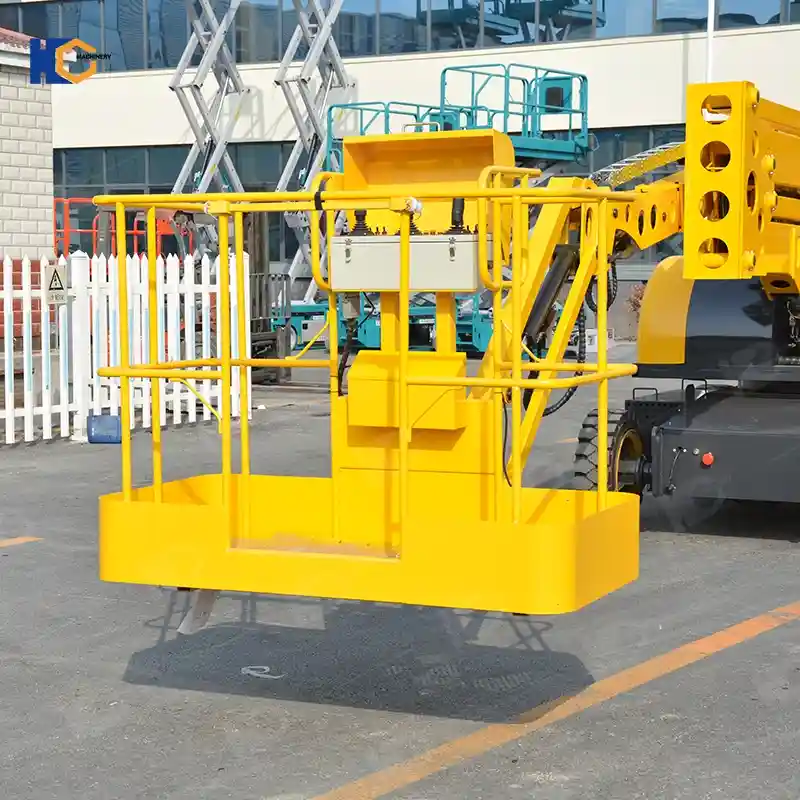
Top 10 Articulating Boom Lift Models for Construction & Maintenance
Choosing the right articulating boom lift is crucial for efficiency and safety in construction, maintenance, and industrial applications. Below, we compare 10 top models, including their specs, best uses, pros/cons, and ideal industries to help you make an informed decision.
1. Genie Z-62/40
Key Specs:
Working Height: 62 ft
Horizontal Reach: 40 ft
Power: Diesel
Capacity: 500 lbs
Best For: Construction, telecom, steel erection
Pros:
Rugged, all-terrain design
Excellent outreach for complex structures
Cons:
Noisier than electric models
Higher emissions (not ideal for indoor use)
2. JLG 600S
Key Specs:
Working Height: 60 ft
Platform Capacity: 500 lbs
Power: Electric
Compact Design: Zero tail swing
Best For: Indoor maintenance, warehouses, facilities
Pros:
Quiet, emission-free operation
Excellent maneuverability in tight spaces
Cons:
Limited outdoor use (soft terrain challenges)
Requires frequent charging
3. Snorkel A46JE
Key Specs:
Working Height: 46 ft
Rotation: 360°
Power: Electric
Capacity: 500 lbs
Best For: Retail, warehouses, indoor repairs
Pros:
Smooth, precise control
Low noise for indoor environments
Cons:
Not suitable for rough terrain
Limited height compared to diesel models
4. JNHC THZB-20-200 (Customizable Model)
Key Specs:
Working Height: 22m (72 ft)
Load Capacity: 200kg (440 lbs)
Power Options: AC / DC / Diesel / Petrol (customizable)
Platform Size: 6.9m x 1.9m x 2.25m (customizable dimensions)
Best For: Specialized industrial, film production, unique job sites
Pros:
Fully customizable (height, power, dimensions)
Versatile for niche applications
Cons:
Longer lead time for custom builds
Higher initial cost for bespoke configurations
5. Skyjack SJ46 AJ
Key Specs:
Working Height: 46 ft
Horizontal Reach: 24 ft
Power: Electric
Capacity: 500 lbs
Best For: Facility maintenance, indoor construction
Pros:
Reliable, low-maintenance design
Excellent for repetitive tasks
Cons:
Not ideal for heavy outdoor use
6. Haulotte HA20 LE (Hybrid Model)
Key Specs:
Working Height: 66 ft
Power: Diesel/Electric Hybrid
Capacity: 500 lbs
Best For: Mixed indoor/outdoor sites, urban construction
Pros:
Fuel-efficient, reduced emissions
Quiet mode for indoor use
Cons:
Higher upfront cost than diesel-only models
7. Manitou 180 TJ (Heavy-Duty)
Key Specs:
Working Height: 59 ft
Capacity: 1,200 lbs
Power: Diesel
Best For: Industrial, shipbuilding, heavy material handling
Pros:
Exceptional load capacity
Robust for tough environments
Cons:
Bulky, less maneuverable
8. Terex TZ34 (Compact Rough-Terrain)
Key Specs:
Working Height: 34 ft
Drive: 4x4 Rough-Terrain
Best For: Landscaping, outdoor maintenance
Pros:
Excellent off-road stability
Compact but powerful
Cons:
Limited height for high-reach tasks
9. Nifty HR15 (Entry-Level)
Key Specs:
Working Height: 49 ft
Power: Diesel
Best For: Small contractors, budget-friendly projects
Pros:
Affordable, reliable
Easy to operate
Cons:
Fewer advanced features
10. UpRight U45 (Versatile All-Rounder)
Key Specs:
Working Height: 45 ft
Power: Electric/Diesel options
Best For: General construction, facility work
Pros:
Balanced performance
Good value for money
Cons:
Not specialized for extreme conditions
Comparison Table
| Model | Height | Capacity | Power | Best Use |
|---|---|---|---|---|
| Genie Z-62/40 | 62 ft | 500 lbs | Diesel | Construction |
| JLG 600S | 60 ft | 500 lbs | Electric | Indoor Maintenance |
| JNHC THZB-20-200 | 72 ft | 440 lbs | Custom | Industrial |
Recommendations
Best for Height: Genie Z-62/40
Best for Indoors: JLG 600S
Most Customizable: JNHC THZB-20-200
This guide helps you match the right articulating boom lift to your construction, maintenance, or industrial needs. Need help choosing? Contact us for expert advice!
How to Choose the Right Articulating Boom Lift for Your Needs
Selecting the ideal articulating boom lift requires careful consideration of your project type, budget, and work environment. Making the right choice ensures safety, efficiency, and cost-effectiveness—whether you're working on a construction site, indoor facility, or industrial plant. Below are the key factors to evaluate when choosing a model.
1. Match the Lift to Your Project Type
The first step is determining whether you need a boom lift for outdoor construction, indoor maintenance, or specialized industrial tasks.
Construction & Heavy-Duty Work → Choose diesel-powered models with high reach (50+ ft) and rough-terrain capabilities (e.g., Genie Z-62/40, Manitou 180 TJ).
Indoor Maintenance & Warehouses → Opt for electric lifts with compact designs and low noise (e.g., JLG 600S, Snorkel A46JE).
Specialized Industrial Needs → Consider customizable options like the JNHC THZB-20-200, which can be tailored for unique height, power, or platform requirements.
2. Consider Budget: Rental vs. Purchase
Your budget plays a crucial role in deciding whether to rent or buy an articulating boom lift.
Short-Term Projects or Testing Equipment → Renting is cost-effective (no maintenance/storage concerns).
Long-Term or Frequent Use → Purchasing may offer better ROI over time.
Hybrid/Electric Models → Higher upfront cost but lower fuel expenses and emissions compliance benefits.
3. Evaluate Terrain & Workspace Conditions
The job site’s terrain determines whether you need a rough-terrain, indoor, or compact lift.
Rough/Uneven Ground (Construction Sites) → Look for 4x4 drive, all-terrain tires, and stabilizers (e.g., Terex TZ34).
Indoor/Confined Spaces (Warehouses, Retail) → Prioritize zero-tail-swing electric lifts (e.g., Skyjack SJ46 AJ).
Mixed-Use (Urban Construction, Facilities) → Hybrid models (e.g., Haulotte HA20 LE) offer flexibility.
Checklist Before Deciding
✔ Height & Reach – Does it cover your required work area?
✔ Load Capacity – Can it safely hold workers + tools?
✔ Power Source – Electric (indoor), diesel (outdoor), or hybrid?
✔ Maneuverability – Compact enough for tight spaces?
✔ Safety Features – OSHA-compliant? (Tilt sensors, emergency descent)
By analyzing these factors, you can select the best articulating boom lift for productivity, safety, and budget efficiency. Need help deciding? Consult with an equipment specialist for personalized recommendations!
Safety Tips for Operating Articulating Boom Lifts
Operating an articulating boom lift requires strict adherence to safety protocols to prevent accidents and ensure OSHA compliance. Follow these essential guidelines to maintain a safe worksite:
1. OSHA Compliance & Operator Training
Certification Required: Only trained and authorized personnel should operate boom lifts (OSHA 1926.453).
Inspect Fall Protection: Workers must wear a full-body harness with a lanyard attached to the platform’s anchor point.
Avoid Overloading: Never exceed the platform’s weight limit (includes workers, tools, and materials).
2. Pre-Operation Checks
Before use, conduct a thorough inspection:
Structural Integrity: Check for hydraulic leaks, cracks, or damaged components.
Controls & Emergency Features: Test lower/raise functions, alarms, and emergency descent systems.
Tires/Outriggers: Ensure proper inflation (if wheeled) and that stabilizers are functional.
Weather Conditions: Avoid operation in high winds (>28 mph) or lightning storms.
3. Preventing Tip-Overs & Falls
Stable Ground Only: Operate on level surfaces—use outriggers on uneven terrain.
Avoid Sudden Movements: No abrupt swings or extensions that could destabilize the lift.
Maintain Safe Distance: Keep the platform at least 10 ft from power lines (OSHA 1926.1408).
No Climbing on Rails: Never stand on guardrails or use ladders inside the platform.
Emergency Protocols
If a Tip-Over Occurs: Stay inside the platform (DO NOT jump)—the cage is designed to protect you.
Stuck in the Air?: Use the manual descent lever if power fails.
Reminder: Safety is non-negotiable. Regular training, equipment maintenance, and hazard awareness can prevent 90% of boom lift accidents (Source: NIOSH).
Conclusion: Choosing the Right Articulating Boom Lift
Selecting the best articulating boom lift depends on your specific project needs, environment, and budget. From our comparison of top 10 models, key recommendations include:
Heavy-Duty Construction → The Genie Z-62/40 (62' reach, diesel-powered) excels in rugged outdoor conditions.
Indoor Maintenance → The JLG 600S (electric, compact) offers quiet, emission-free operation.
Custom Industrial Needs → The JNHC THZB-20-200 provides unmatched customization for specialized tasks.
Budget-Friendly Projects → The Nifty HR15 delivers reliable performance at an affordable price.
Each model has unique strengths—whether it’s height, terrain adaptability, load capacity, or power options. Prioritize safety features, OSHA compliance, and operator training to maximize efficiency and minimize risks.
Need Help Deciding?
Contact our equipment specialists for personalized recommendations, rentals, or purchases. Let us help you find the perfect articulating boom lift for your job!
